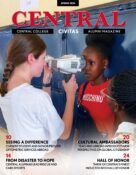
Professor of Biology Russ Benedict holds up a bat for students to examine.
Bats need a good PR person. How often do you hear positive stories about bats?
Unfortunately, appreciation for bats is taking another hit during the COVID-19 pandemic.
And bats do appear to have played a role. The closest DNA match to the virus causing COVID-19 in humans is with a virus found in the intermediate horseshoe bat, a species widespread in China and Southeast Asia. But the DNA is just different enough that it appears the virus did not jump directly from horseshoe bats to humans — a currently unknown third species was involved, possibly a domestic animal or one we use as a food source. Some evidence suggests that the history of this coronavirus involved poorly regulated “wet markets” that sell live or recently slaughtered animals in unsanitary conditions — an ideal place for viruses to move from species to species. Research into the evolution of the virus is advancing rapidly, so stay tuned.
But the bigger story has to do with what we humans are doing.
Roughly 18 months before the pandemic began, researchers predicted a coronavirus outbreak involving bats in southeast China or surrounding areas. Why? Because human activities are driving an increase in disease transmission from wildlife to humans, and that region is an epicenter of these activities. These actions include deforestation, unregulated use of wildlife as food and a rapidly growing human population. As expanding human populations move into wildlife habitats and people exploit wildlife for food or other uses, contact between humans and wildlife increases. And, as people push into natural ecosystems, they bring pets and livestock with them, putting these domestic animals into frequent contact with wild animals as well.
Then there’s climate change: As the world warms, animals either move to stay with their preferred climate or stay put and try to survive warmer conditions and the accompanying increase in “natural” disasters. Both options put animals (and humans) in greater stress. Stress weakens the immune system. Weaker immune systems mean the percentage of the population carrying viruses increases, along with the likelihood viruses will jump from one species to another.
So if you want to blame someone for COVID-19, don’t blame bats — look in a mirror. Viruses like COVID-19 likely have been around for thousands of years — it is the action of we humans that is increasing their impact. Unfortunately, this will not be the last pandemic we face. The pressure humans are putting on the globe will only increase in future decades.












To encourage serious, intellectual discourse on Civitas, please include your first and last name when commenting. Anonymous comments will be removed.
Comments are closed.